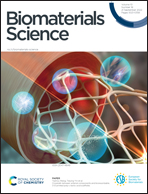Treatment with silica–gold nanostructures decreases inflammation-related gene expression in collagen-induced arthritis†
Abstract
Gold salts have been used to treat rheumatoid arthritis (RA) since the 1940s, and, with advances in nanotechnology, the use of nanogold provides multiple options for anti-inflammatory therapies. This paper presents the synthesis and characterization of silica–gold nanostructures (SGNs) and their therapeutic effect in collagen-induced arthritis (CIA) in DBA/1 mice. At the end of the treatment, the synovial membranes, kidneys, livers, and spleens were dissected and analyzed by inductively coupled plasma mass spectroscopy (ICP) showing less than 0.0001 and 0.1% of the administered doses of Au and Si, respectively. Remains of the SGNs were visually identified in the synovial membrane by scanning electron microscopy (SEM), and the bone density of the hind paws was observed by computerized tomography (CT) indicating a reduction of porosity in the CIA-experimental group. The DNA microarray analysis carried out with RNA obtained from the hind paws showed 2628 differentially expressed genes (DEGs) by SGNs. The bioinformatic analysis showed that DEGs were significantly associated with several inflammatory signalling pathways including chemokines, cytokine–cytokine receptor interaction, PI3K-Akt, TNF, IL-17, NFκβ, MAPK, and RA. SGNs downregulated relevant inflammatory genes in the arthritic joints, including Tnf, Ifng, Il6, and Cxcl5; immunohistochemistry (IHC) confirmed the reduction of TNFα, IL-6, NFκβ, and VEGF in the joints due to the effect of SGNs. TNFα and IL-6 were also reduced in the serum of DBA/1 mice treated with SGNs.



 Please wait while we load your content...
Please wait while we load your content...